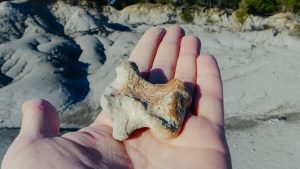Alabama’s Harrell Station, roughly 45 miles west of Montgomery and 150 miles inland from the Gulf of Mexico, seems like the last place someone would go to explore the ocean. But crumbling out of the dusty ground, which has been wrinkled into gullies of white chalk, are the remnants of an ancient sea.

During the Late Cretaceous some 82 million years ago, high temperatures melted the polar ice caps, submerging the world’s coasts. A shallow sea known as the Mississippi Embayment spilled out over the southeastern United States, blanketing much of Alabama. Harrell Station is one of the best places to glimpse this primeval sea.
Located on a belt of Cretaceous-aged rocks known as the Mooreville Chalk, the gullies at Harrell Station are brimming with the immaculately preserved fossilized remains of the reptiles that dominated this ancient sea. Compacted over time, and carved by eons of erosion, the powdery marl is composed of the crushed skeletons of microscopic algae known as coccolithophores combined with clay. As these plankton sank toward the ocean floor, they entombed larger sea creatures in stunning detail.
Read the rest of this article on The Atlantic‘s website!